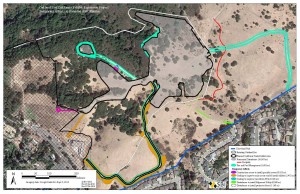Oakland Zoo’s proposed expansion into Knowland Park goes from bad to worse
July 28, 2014
 The Sierra Club has grown increasingly concerned about the California Trails exhibit that the Oakland Zoo proposes to build on the ridge line of Knowland Park. The City of Oakland approved the fifty-six-acre project in 2011 on a fifteen-year-old Mitigated Negative Declaration. Since then, however, the permitting agencies have provided significant pushback to the zoo’s claim that the project would have no significant environmental impacts. The California Department of Fish and Wildlife (CDFW) recommended that the project be built within the zoo’s existing footprint to avoid significant impacts to rare plant communities and to the threatened Alameda whipsnake. The U.S. Fish and Wildlife Service (USFWS), meanwhile, sent the zoo’s application back to the drawing board, noting that the project is at best conceptual.
The Sierra Club has grown increasingly concerned about the California Trails exhibit that the Oakland Zoo proposes to build on the ridge line of Knowland Park. The City of Oakland approved the fifty-six-acre project in 2011 on a fifteen-year-old Mitigated Negative Declaration. Since then, however, the permitting agencies have provided significant pushback to the zoo’s claim that the project would have no significant environmental impacts. The California Department of Fish and Wildlife (CDFW) recommended that the project be built within the zoo’s existing footprint to avoid significant impacts to rare plant communities and to the threatened Alameda whipsnake. The U.S. Fish and Wildlife Service (USFWS), meanwhile, sent the zoo’s application back to the drawing board, noting that the project is at best conceptual.
Two-and-a-half years later, after much heated negotiation, both CDFW and USFWS find that the zoo and the city have each grossly underestimated impacts to Alameda whipsnake habitat, and now require fifty-two acres be set aside for mitigation. In order to fulfill this requirement, the zoo is now proposing that an additional twenty-one acres of Knowland Park land be set aside. In addition to the fact that taking park land for mitigation is double-dipping, this proposal would require the loss of public access to that land.
The parcel in question is closed-canopy oak bay woodland, not the high-quality Alameda whipsnake habitat that the project would destroy. And, because the Deed of Transfer that conveyed the park from the state to the city required that it always remain a public park, removing acreage from public access could potentially trigger the “reverter clause” that would re-convey the land to the state. The zoo and the city are once again offering a ludicrous solution to a self-imposed problem: they propose to keep theappearance of public access by allowing the public to view the twenty-one acres under mitigation from the project’s aerial gondola or a viewing station.
It is clear that the city failed in its fundamental duty as Lead Agency to require a full Environmental Impact Report (EIR). Such a process would have included the critical alternatives analysis, which would have uncovered the major problems with the project and proposed better alternatives. In fact, early in the process the Sierra Club requested that the City conduct a full EIR. The California Native Plant Society’s East Bay Chapter, the California Native Grasslands Association, and Friends of Knowland Park all concurred. As of this writing, not a single East Bay environmental organization endorses this project.
The Sierra Club believes that the public’s right to full and complete access to land in Knowland Park is unequivocal. Furthermore, building on ridge lines, in protected park land, and in listed-species habitat is an affront to conservation principles—especially when there’s more than adequate unused land to accommodate this project within and immediately adjacent to the zoo footprint. The City has dragged the public down a long, twisted path in its quest to accommodate the zoo’s desire to build in the wrong place. The Sierra Club recommends that the City acknowledge that it has gotten in over its head and hit the re-set button.
WhatYouCanDo
Contact Oakland City Council members, the Director of City Planning, and the Office of Parks and Recreation to let them know that you oppose developing high-quality park land.
—Norman La Force, Chair East Bay Public Lands Committee
This article is reprinted with permission from the Sierra Club’s Bay Area publication, the Yodeler. The original may be found on line here.
 Follow
Follow








Comments are closed.